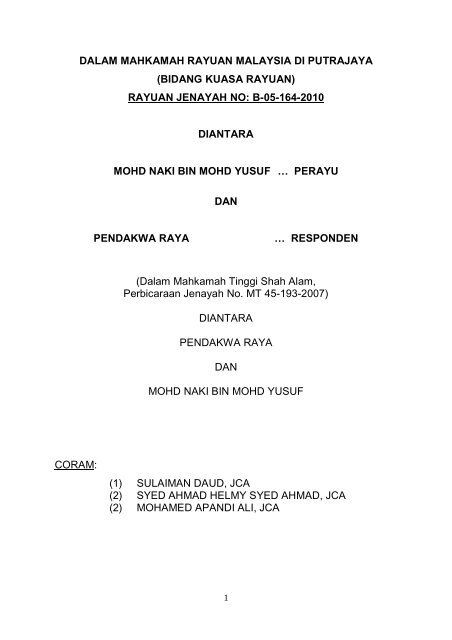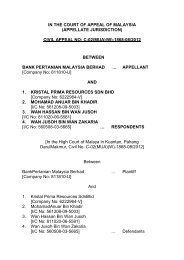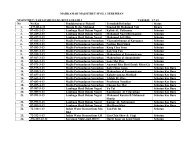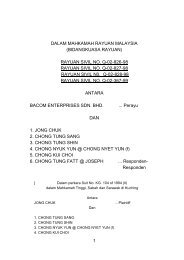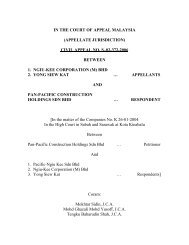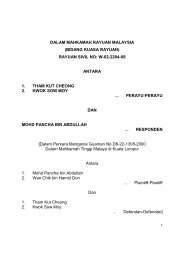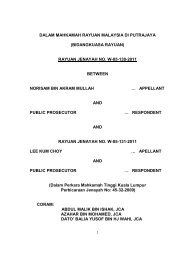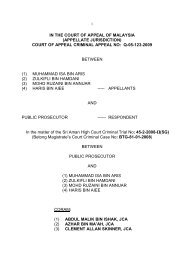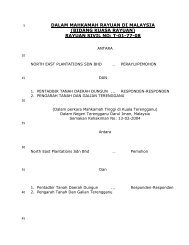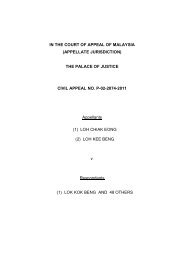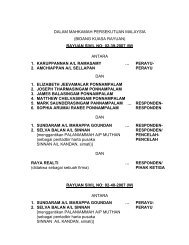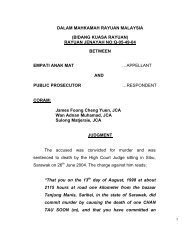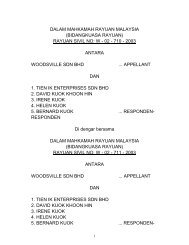(bidang kuasa rayuan) rayuan jenayah no: b-05-164-2010 diantara ...
(bidang kuasa rayuan) rayuan jenayah no: b-05-164-2010 diantara ...
(bidang kuasa rayuan) rayuan jenayah no: b-05-164-2010 diantara ...
Create successful ePaper yourself
Turn your PDF publications into a flip-book with our unique Google optimized e-Paper software.
CORAM:<br />
DALAM MAHKAMAH RAYUAN MALAYSIA DI PUTRAJAYA<br />
(BIDANG KUASA RAYUAN)<br />
RAYUAN JENAYAH NO: B-<strong>05</strong>-<strong>164</strong>-<strong>2010</strong><br />
DIANTARA<br />
MOHD NAKI BIN MOHD YUSUF … PERAYU<br />
DAN<br />
PENDAKWA RAYA … RESPONDEN<br />
(Dalam Mahkamah Tinggi Shah Alam,<br />
Perbicaraan Jenayah No. MT 45-193-2007)<br />
DIANTARA<br />
PENDAKWA RAYA<br />
DAN<br />
MOHD NAKI BIN MOHD YUSUF<br />
(1) SULAIMAN DAUD, JCA<br />
(2) SYED AHMAD HELMY SYED AHMAD, JCA<br />
(2) MOHAMED APANDI ALI, JCA<br />
1
GROUNDS OF JUDGMENT<br />
The appeal herein emanates from the decision of the Shah Alam<br />
High Court in convicting the appellant for the offence of murder under<br />
Section 302 of the Penal Code.<br />
The charge was for the murder of a Pakistani national by the name<br />
of Norshad (holder of Passport No. AB 9613<strong>05</strong>1) and upon conviction<br />
the learned High Court Judge sentenced the appellant to death.<br />
The conviction of the appellant was based on circumstantial<br />
evidence. The narrative of the prosecution’s case which led to the<br />
culpability of the appellant was centred on the evidence of the<br />
appellant’s estranged wife SP18 and his two children SP16 and SP17.<br />
It was the testimony of SP18 that there was a quarrel between her<br />
the appellant and the deceased about a month prior to her lodgement of<br />
a missing person police report on 20.5.2007, which led her to leave their<br />
matrimonial home to stay with her parents in Sungei Besi. On 14.4.2007<br />
the appellant turned up at her parent’s home with his two children SP16<br />
and SP17 leaving them there as he had to leave as something had<br />
happened at the factory.<br />
SP16 and SP17 testified that sometime in April 2007 the deceased<br />
came to their rented house and an argument broke out between the<br />
appellant and the deceased. SP16 saw the appellant hit the deceased<br />
with an iron rod. When they woke up the next day the deceased was<br />
<strong>no</strong>where to be seen.<br />
2
Police investigation recovered an iron rod (P22A) and a machete from<br />
the appellant’s house. The iron rod was found to contain some blood<br />
but <strong>no</strong> DNA profiling was obtained.<br />
The police forensic team collected some samples believed to be<br />
blood from the appellant’s house. The examination and analysis<br />
conducted on a specimen marked A1 obtained from the wall of the<br />
house confirmed that it contained DNA of the deceased.<br />
The other pertinent circumstantial evidence was the testimony of<br />
SP11 an employee of the appellant and the deceased. He testified that<br />
the last time he saw deceased was before 30.4.2007 and when he came<br />
back to work on 4.5.2007 the deceased was <strong>no</strong>where to be found.<br />
SP11 also last saw the appellant on 30.4.3007.<br />
The deceased’s decomposed body was found in a water tank<br />
within the factory on 22.5.2007 by SP2, a police officer who came to the<br />
scene after being informed of a foul smell by SP11. The cause of death<br />
was found by the pathologist SP14 to be head injury or injury to the<br />
brain. The facial bones were smashed and it could be caused by a blunt<br />
object such as a piece of wood or iron rod.<br />
Based on the evidence as presented by the prosecution the<br />
learned trial Judge upon conducting a maximum evaluation thereof was<br />
satisfied that a prima facie case has been established warranting the<br />
calling of the defence of the accused.<br />
The appellant’s defence which was given under oath was a series<br />
of denials - denied that the deceased came to the house on the night in<br />
3
question, denied having seen the murder weapon P26C, denied that the<br />
telephone number “sender” Shah, + 60146600244 belonged to him and<br />
sending an SMS in P30 (1 - 7) therefrom, and denied the contents of the<br />
Police Report P46 made by SP18 pertaining to the telephone call from<br />
telephone number 014 - 6600244 made by the appellant to her. The<br />
appellant also testified that the reason behind leaving the two children<br />
SP16 and SP17 with SP18 to work in Johor was <strong>no</strong>t to run away but<br />
because of the threat by SP18 <strong>no</strong>t to come back to the home as long as<br />
the appellant is around.<br />
The learned trial Judge after evaluating the defence against the<br />
totality of the evidence adduced found that the defence was one<br />
anchored on bare denials and afterthought.<br />
In the appeal before us learned Counsel for the appellant<br />
advanced five grounds of appeal as follows:<br />
1. The trial Judge failed to give adequate consideration of<br />
the absence of the appellant’s DNA on the murder<br />
weapon and at the place of incident.<br />
2. The break in the chain of evidence arising from the<br />
failure to conduct investigation on Shah as the sender<br />
of the SMS message to SP18 on the 23.5.2007<br />
through telephone number 0146600244.<br />
3. The error of the trial Judge to evaluate the evidence of<br />
the pathologist SP14 of the possibility of the head’s<br />
detachment from the body through decomposition and<br />
4
<strong>no</strong>t through the assault on the head with a blunt object<br />
as testified by the first Investigating Officer.<br />
4. Failure by the trial Judge to consider the motive of<br />
SP18.<br />
5. The trial Judge being the third Judge who presided in<br />
the conduct of the trial was in <strong>no</strong> position to evaluate<br />
the demea<strong>no</strong>ur of the testimonies of the earlier<br />
witnesses and fully consider the evidence adduced.<br />
On the challenge against the DNA evidence the thrust thereof is<br />
the absence of the DNA profile of the appellant on the deceased’s body<br />
floating in the water tank and the exhibits of the murder weapon.<br />
DNA evidence is <strong>no</strong>w a very potent weapon of forensic science<br />
which is widely used to assist in proof of identity. In the factual matrix<br />
herein the DNA profile of the deceased was recovered and obtained<br />
from the bloodstain on the wall of the appellant’s home. The recovery of<br />
the bloodstain has to be looked against the presence of the deceased’s<br />
body with multiple injuries floating in the water tank which impels the<br />
inference of the appellant’s culpability as the person who caused the<br />
death of the deceased. There does <strong>no</strong>t appear to be any explanation<br />
proffered by the appellant on this aspect of the evidence. An<br />
explanation from the appellant is imperative in the light of the<br />
consistency in the evidence of the pathologist SP14 and the appellant’s<br />
daughter SP16 who perceived with her own eyes the appellant hitting<br />
the deceased with the iron rod - PP v Hanif Basree Abdul<br />
Rahman[2008] 4 CLJ.<br />
5
It should be recalled that the learned Judge’s conclusion was<br />
derived from his evaluation of the circumstantial evidence, wherein it is<br />
trite the guiding element is the cumulative effect of all the evidence<br />
which leads to the irresistible conclusion of the sole culpability of the<br />
appellant in the commission of the crime. We are of the considered view<br />
that the learned trial Judge adhered to the guidelines and applied the<br />
correct principles in evaluation of circumstantial evidence in arriving at<br />
his decision. Accordingly we dismiss the appellant’s challenge on the<br />
first ground aforesaid.<br />
Coming to the second ground, on the failure of the Investigating<br />
Officer to conduct investigation on Shah as the sender of the SMS<br />
message via telephone number 014 - 6600244 to SP18 on the<br />
23.5.2007 we agree with the findings of the learned trial Judge that it<br />
does <strong>no</strong>t affect the core of the prosecution’s case and does <strong>no</strong>t amount<br />
to a break in the chain of evidence.<br />
In concluding that the failure as such is <strong>no</strong>t fatal the learned trial<br />
Judge was impressed with the demea<strong>no</strong>ur of SP18 whom he found was<br />
a reliable witness whose evidence of the telephone number 014 -<br />
6600244 as belonging to her husband (the appellant) was given<br />
spontaneously and was reflected in her police report P46 which was<br />
made as early as 20.5.2007. The learned trial Judge rationalised that<br />
the <strong>no</strong>n-calling of the telecommunication company personnel as a<br />
witness is at best neutral as it is public k<strong>no</strong>wledge that registration does<br />
<strong>no</strong>t prevent the usage of the registered number by others. The fulcrum<br />
of the basis of his finding was the direct testimony of SP18 that the<br />
number was that of the appellant. The challenge on the second ground<br />
must correspondingly in our view, fail.<br />
6
On the third ground of challenge pertaining to the pathologist<br />
evidence of the possibility that the detachment of the head from the body<br />
could be occasioned by decomposition, we are of the considered view<br />
that the challenge is misplaced and is without merits.<br />
A close scrutiny of the pathologist SP14’s evidence shows that the<br />
head injury and the crushed facial bone which led to the trauma on the<br />
brain of the deceased. The injury as such was according to the<br />
pathologist caused by a blunt object like a piece of wood or an iron rod.<br />
The body of the deceased was found in a water laden underground tank<br />
which accelerated the death occasioned by the trauma to the brain.<br />
The aforesaid cogent piece of evidence of the pathologist was<br />
accepted by the trial Judge and we see <strong>no</strong> grounds to depart.<br />
On the issue of motive, though it is <strong>no</strong>t an element of a murder<br />
charge nevertheless it is a relevant fact to be taken into consideration.<br />
The challenge by the appellant is that the estranged wife SP18 who was<br />
having a love affair with the deceased had the requisite motive to fix up<br />
the appellant with the murder of the deceased. The motive is further<br />
amplified by the threats of SP18 on several occasion to send the<br />
appellant to prison. Hence it is totally unsafe to convict the appellant<br />
without giving adequate consideration to the motive of SP18 which<br />
would have a negative bearing on the element of intention on the part of<br />
the appellant in causing the death of the deceased.<br />
The learned trial Judge addressed his mind to the motive factor.<br />
At page 232 of the Appeal Record he found that the marital relationship<br />
between the appellant and SP18 had broken down occasioned by<br />
7
frequent quarrels. Jealousy would invariably envelope the appellant<br />
upon seeing the deceased establishing a close relationship with SP18,<br />
the level of jealously being dependent on the individual capacity to cope.<br />
In the circumstances we are of the view that though the trial Judge did<br />
<strong>no</strong>t direct his mind to the motive of SP18 vis-à-vis the appellant<br />
nevertheless the failure as such does <strong>no</strong>t absolve the appellant from his<br />
culpability. This is because there is overwhelming circumstantial<br />
evidence to attach culpability on the appellant for the murder of the<br />
deceased.<br />
On the final ground of challenge, though it is true that the trial<br />
Judge being the third Judge who presided and continued with the trial<br />
without having the advantage of ascertaining the demea<strong>no</strong>ur of<br />
witnesses whose testimony was recorded by his predecessors<br />
nevertheless we have adopted the approach and the principles<br />
governing appellate intervention as laid down in the Federal Court case<br />
of Gan Yook Chin (P) & A<strong>no</strong>r v Lee Ing Chin @ Lee Teck Seng & Ors<br />
[2004] CLJ 309 in that:-<br />
“... the central feature of appellate intervention is to determine whether<br />
or <strong>no</strong>t the trial court had arrived at its decision or finding correctly on<br />
the basis of the relevant law and/or the established evidence. In doing<br />
so the Court of Appeal was perfectly entitled to examine the process of<br />
evaluation of the evidence by the trial Court. ...a Judge who was<br />
required to adjudicate upon a dispute must arrive at his decision on an<br />
issue of fact by assessing, weighing and, for good reasons, either<br />
accepting or rejecting this whole or part of the evidence placed before<br />
him.”<br />
8
On the totality of the evidence presented we see <strong>no</strong> error on the<br />
part of the learned trial Judge to rely and evaluate the recorded evidence<br />
of his predecessors to arrive at the decision. The adoption of such a<br />
procedure by the learned trial Judge can<strong>no</strong>t be said to tantamount to<br />
insufficient judicial appreciation of evidence.<br />
The cumulative effect of the evidence of SP16, SP17 and SP18<br />
was more than sufficient evidence to support the findings and conclusion<br />
of the learned trial Judge. The case herein in essence is based on<br />
findings of facts which we have found was <strong>no</strong>t perverse for appellate<br />
intervention. The conviction is safe. The appeal is accordingly<br />
dismissed. Conviction and sentence of the High Court affirmed.<br />
DATUK SYED AHMAD HELMY BIN SYED AHMAD<br />
Judge<br />
Court of Appeal Malaysia<br />
Dated this 28 th May 2012<br />
9
Counsel for the Appellants:<br />
Tetuan Ahmad Nizam & Co.,<br />
Peguambela & Peguamcara<br />
DT-C-7, Le Jardin Deluxe<br />
Jalan Pandan Mewah<br />
Pandan Indah<br />
55100 Kuala Lumpur<br />
Counsel for the Respondent:<br />
Puan Rosidah binti Abu Bakar<br />
Timbalan Pendakwa Raya<br />
Pejabat Timbalan Pendakwa Raya<br />
Unit Pendakwaan Negeri Selangor<br />
Tkt. 4, Podium Utara<br />
Bangunan SSAAS<br />
4<strong>05</strong>12 Shah Alam<br />
Cases referred to in this judgment:<br />
1. PP v Hanif Basree Abdul Rahman[2008] 4 CLJ.<br />
2. Gan Yook Chin (P) & A<strong>no</strong>r v Lee Ing Chin @ Lee Teck Seng & Ors<br />
[2004] CLJ 309<br />
10


